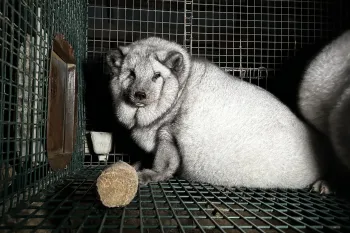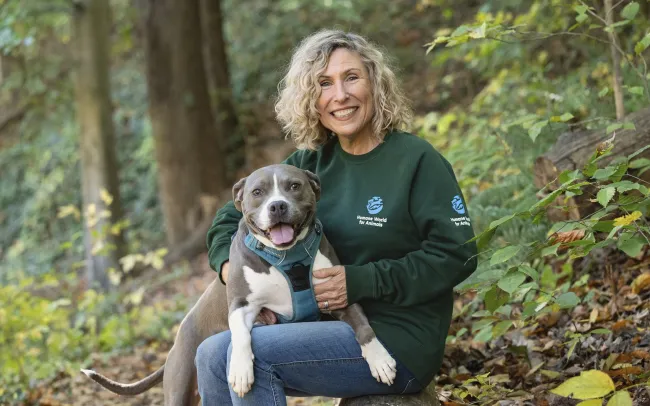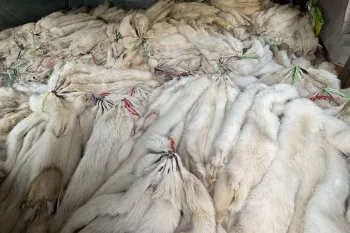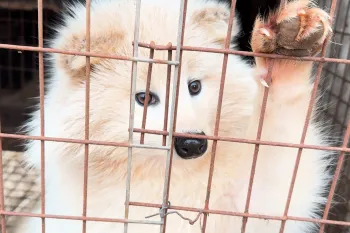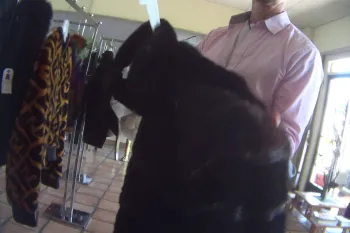It is astonishing that fur farms still even exist, given that they have been exposed as extremely cruel facilities that also pose terrible threats to public health. And yet, even knowing how horrific these places are, each investigation we carry out to expose and end this cruelty shocks me anew.
Our recent investigation in late October looked at fur farms in Finland; Humane Society International/UK partnered with Finnish animal protection organization Oikeutta eläimille to obtain this footage. Because of the public health risks, our investigators took full biosecurity protection measures.
Finland is one of the last remaining European countries where farming animals for fur remains legal. The Finnish trade boasts that almost 100% of its fox fur farms are certified by the SAGA scheme, a set of guidelines promulgated by the Finnish auction house SAGA that promises “the highest level of animal welfare.”
Despite that bold claim, our investigators found foxes, kept in small, barren cages for their entire lives, suffering from raw open wounds, weeping infected eyes and deformed splayed feet. And the method typically used to kill foxes at these facilities is anal electrocution. This is apparently what we can expect of the “highest level of animal welfare” on fur farms.
It's time for the fur industry to stop lying to itself and its consumers and admit it: There is no way to make fur farming anything but abhorrently cruel to its animal victims—and dangerous to people everywhere.
In recent years, there have been alarming outbreaks of COVID-19 and highly pathogenic avian influenza on more than 500 fur farms in Europe and North America. After the avian flu outbreaks on fur farms in Finland in 2023, Finnish authorities introduced some biosecurity measures to prevent disease spread: These included requiring the use of netting to prevent wild birds from accessing the housed animals’ cages and their food and drinking water, and mandatory carcass testing periods. The netting is required to be checked regularly, and any birds observed inside must be removed immediately.
And yet, our investigation found these regulations being flouted. In many instances the netting failed to cover the full length of the cages. Investigators found the decaying body of a wild gull just beneath a row of caged foxes.
Sally Ivens/HSI
The physical harms and risks in these terrible operations are compounded by the clear moral wrongs done to the animals, who are bred to become obese “monster foxes” with unnaturally excessive skin folds from selective breeding to increase their fur yield. Trapped in their small, barren cages until their death, they display repetitive behaviors indicative of mental distress, unable to express natural behaviors such as running, digging and hunting.
Our UK team is using these findings to push the government there to rapidly take action on a bill to prohibit the import and sale of fur. In October 2024, we welcomed this draft law as a significant step forward. If passed into law, the ban would end the UK’s complicity in the cruelty and public health risk of the global fur trade. We estimate that the amount of fur imported into the UK over five years equates to approximately 7 million animals killed. Fox fur originating from Finland is used by brands such as Woolrich, Ermanno Scervino, Yves Salomon and Fendi.
In total, 22 European countries have banned the fur farming industry, and we urge the Finnish government to follow this path, supporting farmers where necessary to secure a rapid closure of this industry.
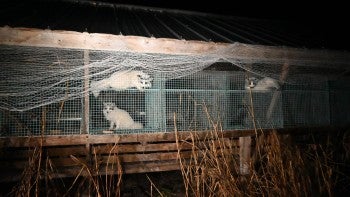
Sally Ivens/HSI
“I’ve visited around 20 fur farms in the past six years, and from what I’ve witnessed on every occasion it’s clear that the fur trade routinely disregards both animal welfare and public health,” said Claire Bass, senior director of campaigns and public affairs at Humane Society International/UK. “These appalling conditions are worlds apart from the ‘luxury’ image the fur trade tries to portray.”
“Finnish fur farms are a disease disaster waiting to happen,” added Kristo Muurimaa of Oikeutta eläimille. “The cages are open to the elements, and there’s no way to reliably prevent avian influenza or other possibly dangerous viruses from spreading.”
It’s essential to point out that the U.S. is years behind in every respect. In the U.S., fur farms are so poorly regulated that we do not actually even know how many fur farms there are. Nor are U.S. state and federal agencies even testing fur factory farms for threatening and potentially deadly diseases. The U.S. is also the third-largest buyer of fur products in the world. This is unacceptable.
We are committed to doing everything we can to expose the cruelties and dangers of fur farming in the U.S. and all over the world until this industry finally collapses under the weight of the social, cultural and political forces we’re helping to bring to bear through investigations like this one.
Sign our petition urging an end to the cruel and deadly fur farming industry.
Follow Kitty Block @HSUSKittyBlock.
